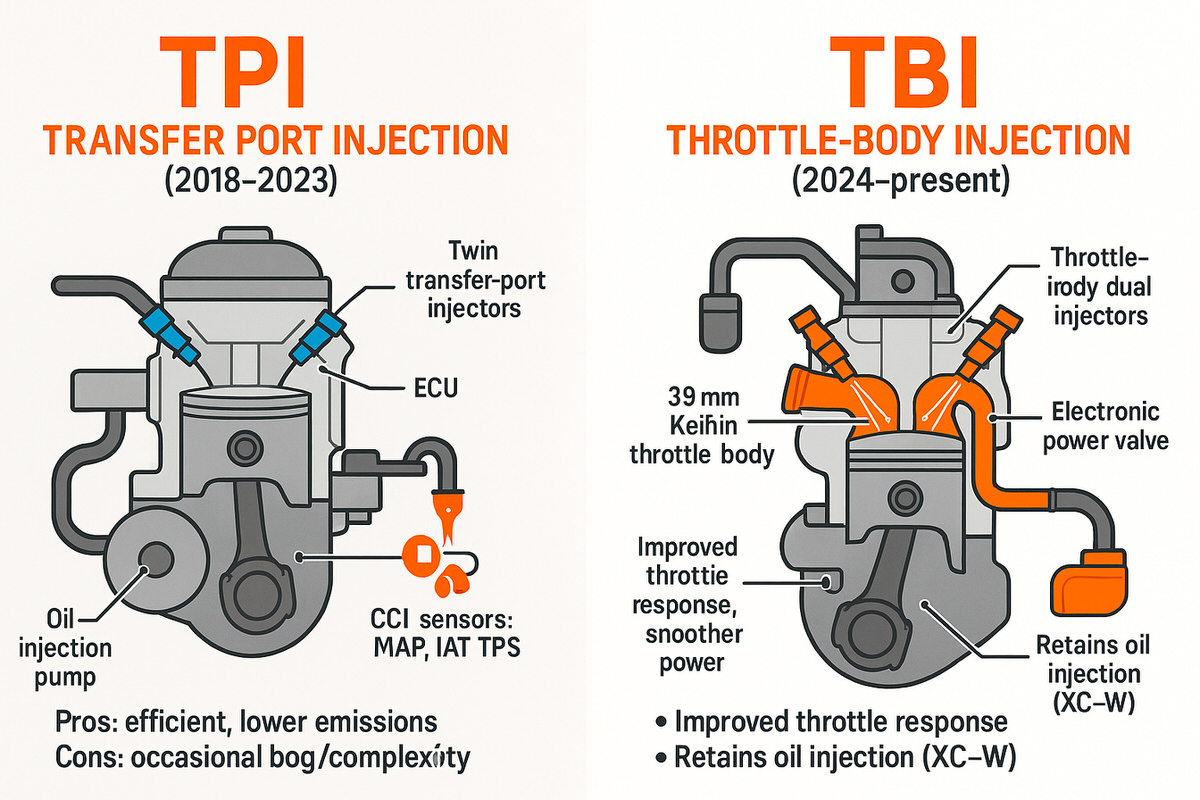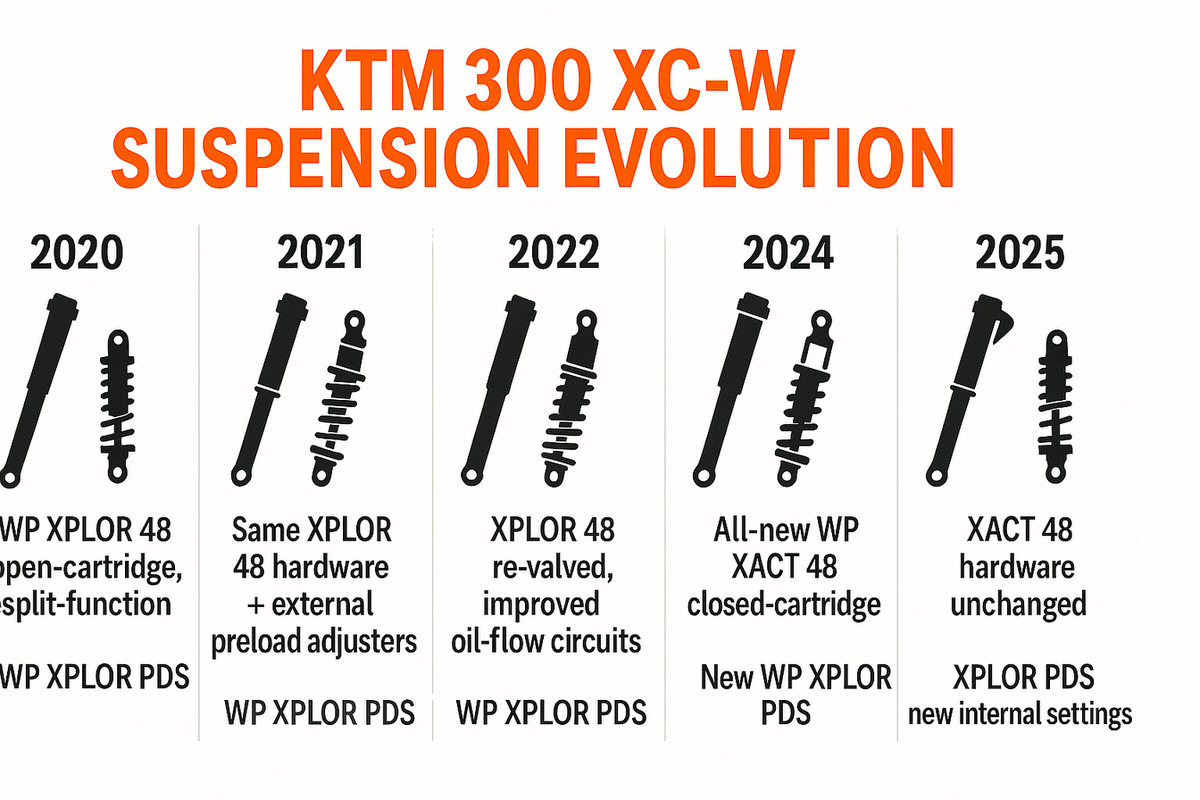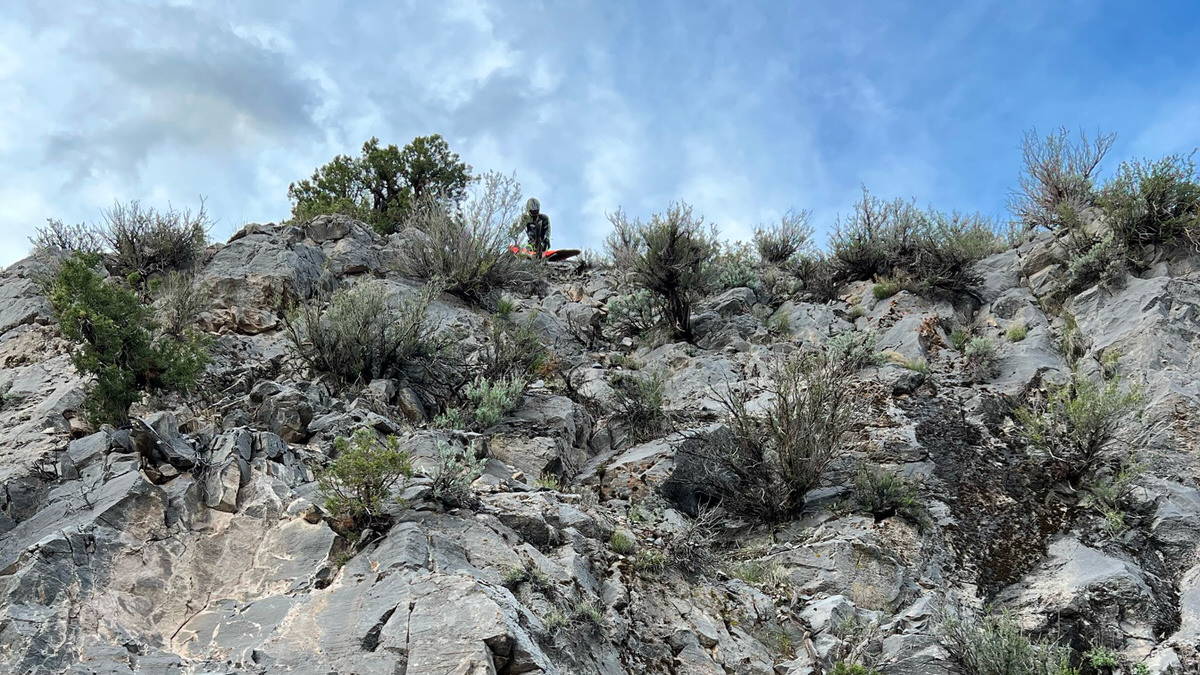TBI vs TPI Explained: KTM's Fuel Injection Systems Decoded
KTM's shift from TPI to TBI has riders confused. This technical deep-dive explains both fuel injection systems, their real-world differences, and what it means for your next bike purchase.

The biggest debate in modern two-stroke technology isn’t about premix ratios or jetting anymore - it’s TBI versus TPI. KTM’s fuel injection evolution has created two distinct camps, each convinced their system is superior. After servicing hundreds of both systems, here’s the unfiltered technical breakdown you need.
The Technical Foundation
Understanding the Basics
Before diving into TBI vs TPI, let’s establish what we’re comparing:
Traditional Carburetor:
- Mechanical fuel delivery
- Atmospheric pressure dependent
- Manual jetting required
- Simple but imprecise
Fuel Injection Goals:
- Consistent fuel delivery
- Altitude compensation
- Temperature adaptation
- Emissions compliance
KTM 300 XC-W Fuel-Injection Evolution
The evolution from carburetors to TPI to TBI represents a massive leap in two-stroke technology. Here’s the complete technical breakdown:
| Feature | TPI – Transfer Port Injection (2018–2023) | TBI – Throttle Body Injection (2024-present) |
|---|---|---|
| Injector Location | Two small injectors sit in the cylinder’s transfer-ports, spraying fuel sideways into the airflow just before it enters the combustion chamber | Twin injectors are housed in a new 39mm Keihin throttle body, spraying fuel into the intake tract ahead of the reed valve |
| Oil Supply | Separate oil-injection pump feeds the crankcase—no pre-mixing | XC-W models keep the oil-injection pump (straight pump gas). XC models require traditional premix |
| Sensors/ECU | ECU references crankcase-pressure, MAP, IAT, TPS and more to meter fuel | ECU now measures additional crankcase and ambient data, plus throttle angle, to fine-tune mixture every ride |
| Ride Feel | Smooth, fuel-efficient and altitude-adaptive, but some riders noted a slight “bog” or inconsistent power when lugging | Crisper throttle response, stronger bottom-end, and smoother power delivery; eliminates most TPI drivability quirks |
| Emissions/Economy | Designed to meet Euro 4/5 and US EPA off-road standards with very low oil consumption | Meets the next round of emissions while giving 4-stroke-like precision in fueling |
| Service Quirks | Two injectors in the cylinder add complexity when removing the top-end | Easier cylinder service but adds an extra high-pressure fuel line to the throttle body |
| Bottom Line | Revolutionary for 2-strokes—first production EFI system that injected directly into the transfer ports. Great fuel range and altitude compensation | Next-gen refinement: moves injection upstream for even smoother combustion, adds electronic power-valve management, and retains the convenience of oil injection on trail-oriented XC-W models |
Why KTM Moved to TBI
The shift from TPI to TBI wasn’t just change for change’s sake. Three key factors drove the evolution:
1. Throttle Feel & Torque
Placing the injectors in the throttle body improves atomization at low throttle openings, giving a more carb-like hit while keeping EFI precision. This addresses the main complaint about TPI’s occasionally “dead” feeling at low RPM.
2. Single Calibration Envelope
TPI’s crankcase-pressure sensor sometimes struggled with very steep climbs/descents. TBI’s sensor set is less sensitive to orientation, providing more consistent fueling regardless of bike angle.
3. Shared Hardware
Keihin’s 39mm throttle body and ECU architecture match KTM’s 4-stroke bikes, simplifying parts and tooling across the range. This means better parts availability and potentially lower costs long-term.
Real-World Comparison
Power Delivery Analysis
TPI Characteristics:
- Torque: Broad, usable spread
- Peak HP: Slightly lower (2-3hp)
- Delivery: Electric smooth
- Best for: Technical terrain
TBI Characteristics:
- Torque: More peaky
- Peak HP: Traditional output
- Delivery: Classic two-stroke hit
- Best for: Open terrain, racing
Maintenance Requirements
TPI Service Intervals:
- Injector cleaning: 100 hours
- Throttle body service: 150 hours
- Oil pump inspection: 200 hours
- ECU updates: As released
TBI Service Intervals:
- Injector cleaning: 150 hours
- Basic service: 200 hours
- Premix consistency: Every tank
- Simpler overall maintenance
Cost Analysis
Initial Purchase:
- TPI models: $500-800 premium
- TBI models: Base pricing
- Used market: TPI depreciation higher
- Warranty considerations
Long-term Ownership:
- TPI: Higher service costs
- TBI: Traditional maintenance
- Parts availability: TBI simpler
- DIY friendly: TBI wins
Which System for Which Rider?
TPI is Ideal For:
Technical Terrain Specialists:
- Trials background riders
- Extreme enduro competitors
- Precise throttle control needs
- Convenience priority
Altitude Variation Riders:
- Mountain riding
- Frequent elevation changes
- No jetting hassles
- Consistent performance
Emission Conscious:
- Euro 5 compliance
- Cleaner operation
- Less smoke/smell
- Environmental consideration
TBI is Perfect For:
Traditional Two-Stroke Fans:
- Want the “hit”
- Enjoy premixing ritual
- Mechanical sympathy
- Simple is better mindset
Desert/Open Terrain:
- Top-end power priority
- Less technical riding
- Racing applications
- Aggressive riding style
Budget Conscious:
- Lower purchase price
- Cheaper maintenance
- DIY repairs possible
- Parts availability
Tuning and Modifications
TPI Tuning Options
Limited but Available:
- Mapping Tools: GET or Mexxer ECU
- Exhaust Systems: Specific TPI designs
- Air Boot Mods: Increased flow
- Injector Upgrades: Higher flow units
Cost Reality: $500-1500 for basic tuning
TBI Tuning Advantages
More Accessible Tuning:
- ECU Remapping: Simpler architecture
- Exhaust Options: Standard two-stroke compatibility
- Intake Mods: Traditional improvements work
- Power Valve: Electronic management allows tuning
Cost Reality: $200-600 for significant gains
Common Issues and Solutions
TPI Problems
Injector Clogging:
- Symptom: Rough idle, poor running
- Solution: Ultrasonic cleaning
- Prevention: Quality fuel, filters
- Cost: $150-200 service
Oil Pump Failures:
- Symptom: Seizure risk
- Solution: Replacement required
- Prevention: Regular inspection
- Cost: $400-600 parts/labor
TBI Considerations
Potential Issues:
- Throttle body contamination
- High-pressure fuel line maintenance
- Sensor calibration drift
- Power valve electronic issues
Advantages:
- Simpler cylinder service
- Shared parts with 4-strokes
- Most mechanics comfortable with throttle body systems
- Oil injection retained on XC-W trail models (XC racing models use premix)
The Utah Perspective
Local Conditions Impact
High Altitude Consideration:
- TPI: Seamless adjustment
- TBI: Manual compensation
- Winner: TPI for mountains
Technical Terrain:
- TPI: Superior control
- TBI: More abrupt
- Winner: TPI for rocks
Desert Racing:
- TPI: Efficiency advantage
- TBI: Power characteristic
- Winner: TBI for speed
Future Development
Industry Direction
2025 Model Trends:
- KTM: Both systems offered
- Competition: Following suit
- Technology: Continued refinement
- Market: Split remains
Predicted Evolution:
- Simplified TPI systems
- Enhanced TBI mapping
- Hybrid approaches possible
- Consumer choice continues
Making Your Decision
Key Questions to Ask
- What’s your terrain? Technical = TPI’s smooth delivery, Open = TBI’s crisp response
- Maintenance approach? Complex OK = TPI, Simple preferred = TBI
- Oil system preference? XC-W models retain oil injection, XC models require premix
- Budget for repairs? Lower = TBI’s simpler system, Higher = Either
- Riding style? Smooth/technical = TPI, Aggressive/racing = TBI
Test Ride Imperative
Never buy based on internet opinions alone:
- Ride both systems back-to-back
- Same terrain comparison
- Multiple conditions ideal
- Trust your preference
The Bottom Line
Neither system is definitively “better” - they’re different tools for different jobs. TPI offers sophistication, convenience, and smooth power delivery perfect for technical terrain. TBI provides simplicity, traditional character, and easier modification for riders who know what they want.
The real winner? Riders. We now have choices that didn’t exist five years ago. Both systems are light-years ahead of carburetors in consistency and performance. Pick based on your riding style, not internet arguments.
Still confused? We service both systems daily. Contact us for an honest assessment based on your specific riding needs and local terrain.
What’s your experience with TPI or TBI? Share your real-world feedback in the comments.
Tagged with:
About Mountain Goat Sports
Professional motorcycle repair & suspension tuning for Utah hard enduro riders. Specializing in KTM, Husqvarna, and GasGas dirt bikes.
Related Articles

Red Trail Guide: San Rafael Swell's Technical Challenge
The Red Trail in the San Rafael Swell delivers one of Utah’s most rewarding technical single track experiences. This ...

Suspension Setup for Rocky Terrain: The Utah Dialing Guide
Rocky terrain demands specific suspension settings. This comprehensive guide breaks down exactly how to set up your W...

The Ultimate Guide to Utah Hard Enduro Riding
Utah offers some of North America's most challenging hard enduro terrain. This comprehensive guide covers everything ...

Winter Riding in Warner Valley: Utah's Desert Escape
When northern Utah's trails are buried under snow, Warner Valley offers perfect riding conditions with 60-degree temp...
Need Service for Your Bike?
Our expert technicians are ready to help with all your motorcycle needs. From suspension tuning to engine rebuilds, we've got you covered.